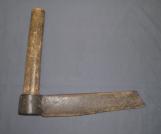1
For every part of a building there was a special tool designed to make the task of construction a lot easier. These tools were an extension of the human hand and were often beautifully designed.2
Broad AxeMid - Late 1800's
South Grey Museum, Flesherton, Ontario, Canada
 Credits:
Credits:South Grey Museum Collection
3
The Axe was a multi purpose tool often used for felling trees or for mortising the beams in barns.4
Cross-cut SawLate 19th to early 20th century
South Grey Museum, Flesherton, Ontario, Canada
 Credits:
Credits:South Grey Museum Collection
5
This type of saw, known as a "cross-cut saw" was used to cut horizontally through the trunk of a tree by two people using a push-pull motion. The handles are detachable so they can quickly be pulled out of the trunk of the tree. Through a combination of teeth and "rakers", designed to remove the sawdust from the cut, this was a very effective saw for cutting down lumber.6
Carpenter's Adzmid-to late 1800`s
South Grey Museum, Flesherton, Ontario, Canada
 Credits:
Credits:South Grey Museum Collection
7
The Carpenter's Adze was used for the intial shaping of timber and smoothing the surface for use in rough construction such as barns and log homes or as the first step to the creation of framing, flooring, siding, etc.9
The striking maul, often made of a wooden burl, was used to hit the froe. A metal or iron maul or mallet would damage the froe.10
Froemid-late 1800's
South Grey Museum, Flesherton, Ontario, Canada
 Credits:
Credits:South Grey Museum Collection
11
The Froe is a traditional tool for splitting straight-grained wood such as riving (splitting) long railing stock (for a split rail fence) and for splitting shakes. Often used in conjunction with a striking maul (large wooden mallet). Could not use an iron maul as it would damage the froe.To use you knock the froe "blade" into the end of a small pole and then push, tap, wiggle the froe as you're driving/moving it down the length of the pole. Most commonly used to hand split shakes and shingles...in which case you line up the froe at the point you want to split the shake, give the top of the froe blade a healthy tap (or two), and follow with a quick twist (back or forth motion) to the haft (handle) to 'pop' the shake or shingle free of the shake bolt (the chunk of wood you're using to make the shakes/shingles). For all but the best ax pros, the froe is a more accurate tool, allowing you to set the blade precisely where you would like to split the wood.

